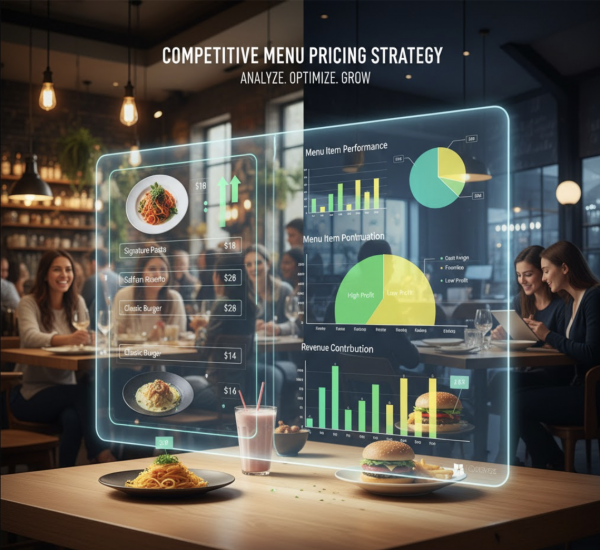Pricing mistakes may silently kill restaurant profits every day. You may have the best recipes, the friendliest staff, a stunning ambiance, and unforgettable flavors. But if your menu prices don’t match customer expectations and market trends, all that hard work won’t pay off.
Many restaurant owners struggle because they don’t know what their competitors are charging or how diners perceive value. Getting this balance helps you make strategic pricing decisions that can protect your profit margins and keep customers coming back.
In this guide, you will explore how you can optimize your restaurant’s pricing strategy to outsmart the competition and drive sustainable growth.
What Is Competitive Menu Pricing?
Competitive menu pricing is a strategy where you set your restaurant’s prices by analyzing what your competitors charge. It also considers your market position, costs, and customer expectations.
Rather than simply adding a markup to ingredient costs, competitive pricing focuses on what similar restaurants charge for comparable dishes. This approach helps your restaurant attract more customers while maintaining healthy profit margins.
What is Menu Analysis and Why It Is Essential for Success
To set competitive menu prices, you need to start with a menu analysis. Review how each item performs and its contribution to the revenue collection.
With restaurant menu analytics, you can spot your most profitable dishes, customer favorites, and ordering patterns.
For example, if your signature pasta is popular but has low profit, adjust portions or bundle it with a drink or appetizer to boost revenue.
Menu analysis also identifies underperforming items, which can be revised or repriced to improve margins without hurting customer satisfaction.
How Restaurant Competitor Analysis Shapes Pricing Decisions
Understanding what your competitors are charging is essential for setting effective menu prices. A restaurant competitor analysis involves reviewing other restaurants’ menus, prices, promotions, and overall market positioning to determine where your business fits in.
This process reveals pricing opportunities and clarifies whether your restaurant should be positioned as affordable or premium. It also highlights broader market trends.
For example, if several competitors increase their prices, it could indicate that customers are willing to pay more. Similarly, if a nearby restaurant offers a specialty dish at a higher price, you could create a comparable item with a unique twist to justify a premium rate.
By monitoring your competitors, you can set prices that reflect market demand and ensure your most popular items are priced for maximum profitability.
Top 4 Menu Pricing Strategies Every Restaurant Should Know
Once you’ve analyzed your menu and competitors, you can use these strategies to price your items effectively while staying competitive:
Price Skimming
Price skimming involves launching a new or high-demand dish at a premium price, often above what competitors charge. This strategy works best for unique or innovative menu items that attract early customers willing to pay extra for something special.
For example, if your restaurant introduces a limited-edition saffron risotto that no nearby restaurants offer, you can price it at $28 instead of the usual $18 for risotto. Over time, you can reduce the price to attract a wider audience while maximizing initial revenue.
Penetration Pricing
Penetration pricing is the opposite approach. You set prices lower than competitors to attract new customers quickly. This is ideal for new restaurants or items entering a competitive market.
For instance, if most local smoothie bars charge $7 for a mango smoothie, you could offer yours for $5.50. This draws in price-conscious customers and encourages trial, and your smoothie can become a popular choice.
Once you build loyalty, you can gradually increase the prices without losing your customer base.
Competitive Pricing
Competitive pricing is about setting your menu prices based on what competitors are charging. The goal is to match or slightly undercut competitors to attract price-sensitive customers. This strategy works best in markets where there are many similar options, and customers are making decisions based on price.
For example, if your competitors charge $14 for a burger, you might choose to price yours at $13.50, slightly undercutting their price to entice customers to choose your restaurant over others.
Bundle Pricing
Bundle pricing is a strategy where you offer multiple items together at a discounted price, which creates perceived value for the customer. For example, you can create a bundle deal for a burger, fries, and a drink for $12.50, when each item individually costs $5.
By offering the bundle, customers feel like they are getting a better deal.
Mapchise – The Secret Weapon for Smart Menu Pricing
If you want to stay ahead in a competitive market, consider using tools like Mapchise. This platform provides restaurant menu analytics and restaurant competitor analysis to help you make data-driven decisions about your menu pricing.
With real-time insights, Mapchise helps you track competitor pricing, customer behavior, and local market trends. It gives you the edge to adjust your menu strategically and keep your prices competitive.
Conclusion
In a highly competitive restaurant market, smart pricing is everything. A well-thought-out competitive menu helps you attract more customers and increase your profit margins.
By understanding your menu and keeping an eye on competitors, you can set prices that reflect your value and match what customers expect.
As your business grows, remember menu pricing isn’t fixed. It should change as trends and customer preferences evolve. Tools like Mapchise can make this easier and help you make smarter pricing decisions.
FAQs
How often should I update my menu prices?
You should revise menu prices regularly, at least every quarter or after significant changes in food costs or competitor pricing. Regular updates help you stay competitive and profitable.
Can competitive pricing help me increase customer loyalty?
Competitive pricing can attract price-sensitive customers and increase foot traffic. Still, it is crucial to balance competitive prices with high-quality offerings and excellent customer service to build long-term loyalty.
Can small restaurants benefit from competitor analysis?
Small restaurants can use competitor analysis to understand local pricing trends and spot gaps in the market. This helps them position their menu items strategically and maintain healthy profits.


